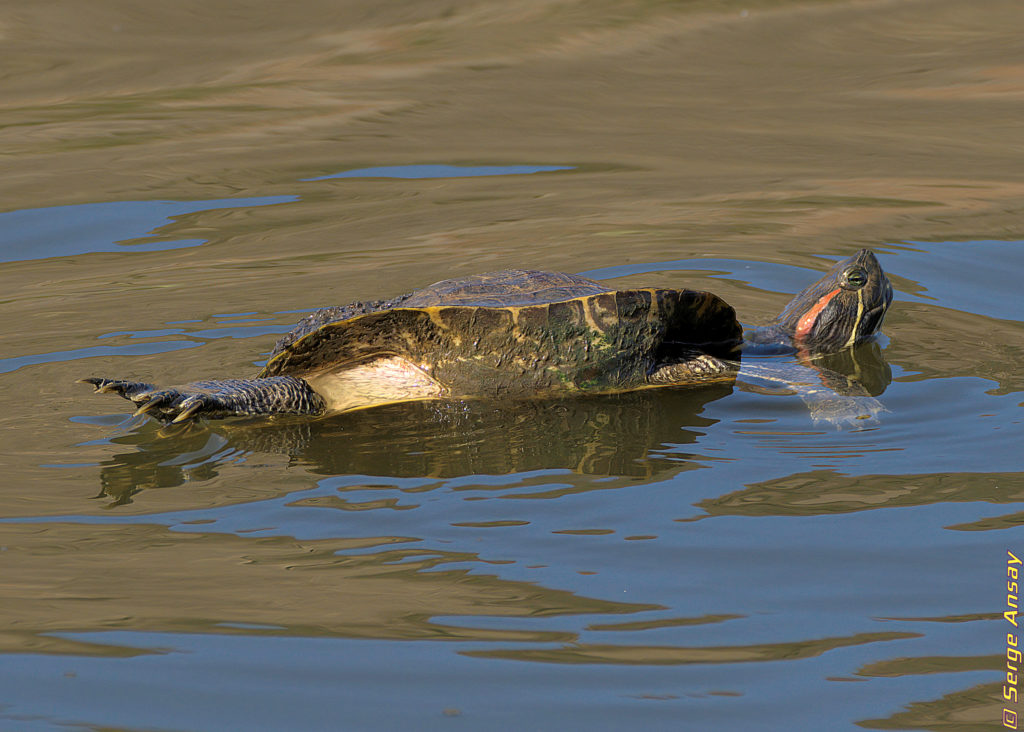This series was taken at the end of last year. I was walking along the shore of lake Hodges, and I spotted this turtle in the water. As you will see on the pictures in this gallery, it was leaning to one side, and there was mud on its carapace.
This was a rather strange sight, and it remains a mystery to this day. I couldn’t do anything for that turtle because it was too far in the water. I was thinking, if I can get close enough, maybe I can clean off that mud. Perhaps it’s the weight of the mud that made it swim at a weird angle. But then, I also thought, perhaps it’s been attacked and it’s wounded. Anyway, all I could do is wonder and document this strange little event.
Now regarding that turtle, this was a red-eared slider. In some websites, it is called an “alien” species because it’s not native to California. As indicated in the Wikipedia page provided, it is native to southern United States and northern Mexico. It was introduced to California by pet owners who, either willingly or not, let them loose in the wilderness. But the problem is that it is also an “invasive” species. That term, “invasive” means that the species in question has a negative effect in the environment where it’s been spreading.
Well, that’s a problem we, human beings, have created. So, why should that particular turtle bear the blame? As far as I am concerned, it deserves as much attention as any of the other creatures in our environment. But that’s my point of view. Feel free to disagree and let me know, the comments section is there for that, besides the usual compliments ?
I was really curious as to why this turtle is identified as “invasive” and what are the negative consequences of that. This text found on this government wildlife web page explains this very well:
“Introduced red-eared sliders compete with native species for food and habitat. For example, in California and the other Pacific states, sliders compete with native western pond turtles for food, egg-laying sites, and basking sites. Red-eared sliders are also vectors of disease and can transmit parasites to native animal species, as well as the bacteria Salmonella to humans. The sale and distribution of viable eggs and all small turtles (shell length less than 4 inches) was banned, excepting educational and research purposes, in the United States in 1975 after public health investigations showed that small turtles were a major source of human Salmonella infections. Over time, the extensive use of antibiotics within turtle hatcheries has resulted in the development of antibiotic-resistant strains of Salmonella, further exacerbating the threat to humans, if spread. Introduced populations can expand rapidly, with female red-eared sliders able to lay up to 6 clutches per year, each containing up to 30 eggs.”
Interestingly enough I also read that they suggest you to report your sightings for tracking purposes. What do you think? Should I send them the link to this post?
Here is a little more information regarding this turtle:
- The red-eared slider is the most common reptile pet in the world.
- Turtles are reptiles and so, they are poikilotherms, which means that their body doesn’t have an internal temperature regulation like us. So they have to rely on the sun to keep warm. If it gets too cold they will brumate, which is a process of slowing down all activity, similar to hibernation. But it’s different for reptiles because their metabolisms is very different from, say, mammals.
- Some website state that they will live up to 40 years in the wild, but less in captivity. Others say the opposite, so I am not sure what to believe. In general animals live longer in captivity because they are fed regularly and they don’t have to fear predators. I saw comments about the main problem being poor maintenance by the owners.
- They are omnivores, which means everything. So they will eat plants, insects, small fish, shrimp, etc.
- Red-eared sliders can carry salmonella without being affected. For this reason there is a ban in USA of sale of small turtles (less than 4 inches shell) and eggs.








That red stripe is so strong in contrast! Love turtles ?
Nice to hear from you my friend 😀
I only wished my story was more uplifting, but this is life. Sometimes it’s not so good. And I believe that everything is worthy of being seen, known.
It looks like this turtle is basking or sun bathing, a common behavior of the species. They typically extend the hind feet toward the sun when doing this and orient their body for maximum exposure to the sun. Debris on the shell is probably just a coincidence.